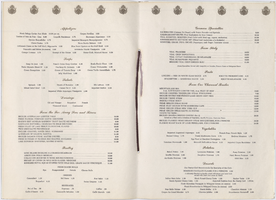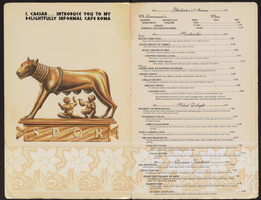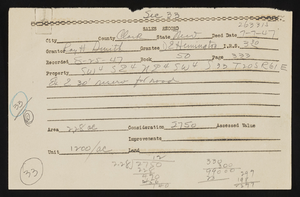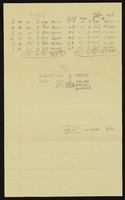Search the Special Collections and Archives Portal
Search Results

Interview with Corbin Harney, July 24, 2006
Date
2006-07-24
Archival Collection
Description
Narrator affiliation: Western Shoshone Spiritual Leader; Protester
Text
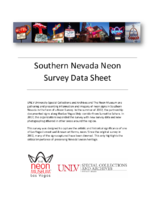
The Beat Coffeehouse Neon Survey document, September 17, 2017
Date
2017-09-17
Archival Collection
Description
Information about the The Beat Coffeehouse sign that sits at 520 Fremont St.
Site address: 520 Fremont St
Sign owner: Michael and Jennifer Cornthwaite
Sign details: This location opened in 2009, but closed in 2016. It will reopen as Eureka!, which is a chain of restaurants based in California.
Sign condition: 5- was a relatively new sign and shined brightly
Sign form: Hanging sign
Sign-specific description: This sign was skeletal neon making the letters "the beat" in a bubble letter font. The word 'the' lights up blue and 'beat' is red neon.
Sign - type of display: Neon
Sign - media: Steel
Sign environment: This location is in the Fremont East District on Fremont and 6th Street in the Emergency Arts Center.
Sign - date of redesign/move: Currently this sign is not visible from public view
Sign - thematic influences: This sign showcases a good use of skeletal neon.
Sign - artistic significance: The property's decor is representative of the bohemian, indie, hipster trend of the mid 2000s into the the 2010s.
Survey - research locations: Review Journal article https://www.reviewjournal.com/entertainment/food/the-beat-coffeehouse-in-downtown-las-vegas-to-close-later-this-year/ , The Beat website http://www.thebeatlv.com/ , Las Vegas Weekly article https://lasvegasweekly.com/intersection/2016/jul/12/losing-the-beat-coffeehouse-detriment-to-downtown/ , Vegas Eater website https://vegas.eater.com/2016/9/26/13051480/the-beat-coffeehouse-closes
Surveyor: Wyatt Currie-Diamond
Survey - date completed: 2017-09-17
Sign keywords: Neon; Hanging
Site address: 520 Fremont St
Sign owner: Michael and Jennifer Cornthwaite
Sign details: This location opened in 2009, but closed in 2016. It will reopen as Eureka!, which is a chain of restaurants based in California.
Sign condition: 5- was a relatively new sign and shined brightly
Sign form: Hanging sign
Sign-specific description: This sign was skeletal neon making the letters "the beat" in a bubble letter font. The word 'the' lights up blue and 'beat' is red neon.
Sign - type of display: Neon
Sign - media: Steel
Sign environment: This location is in the Fremont East District on Fremont and 6th Street in the Emergency Arts Center.
Sign - date of redesign/move: Currently this sign is not visible from public view
Sign - thematic influences: This sign showcases a good use of skeletal neon.
Sign - artistic significance: The property's decor is representative of the bohemian, indie, hipster trend of the mid 2000s into the the 2010s.
Survey - research locations: Review Journal article https://www.reviewjournal.com/entertainment/food/the-beat-coffeehouse-in-downtown-las-vegas-to-close-later-this-year/ , The Beat website http://www.thebeatlv.com/ , Las Vegas Weekly article https://lasvegasweekly.com/intersection/2016/jul/12/losing-the-beat-coffeehouse-detriment-to-downtown/ , Vegas Eater website https://vegas.eater.com/2016/9/26/13051480/the-beat-coffeehouse-closes
Surveyor: Wyatt Currie-Diamond
Survey - date completed: 2017-09-17
Sign keywords: Neon; Hanging
Text

Cindy Baca oral history interview: transcript
Date
2019-05-22
Archival Collection
Description
Oral history interview with Cindy Baca conducted by Barbara Tabach on May 22, 2019 for the Remembering 1 October Oral History Project. Cindy Baca, born and raised in Las Vegas, talks about her family and occupation as a librarian at Escobedo Middle School. Cindy's twin daughters were present and injured during the Route 91 Festival and October 1 shooting. She describes their experiences and the Random Acts of Kindness project she piloted at her school after the incident.
Text
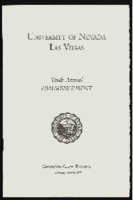
University of Nevada, Las Vegas (UNLV) 10th commencement program
Date
1973-05-09
Archival Collection
Description
Commencement program from University of Nevada, Las Vegas Commencement Programs and Graduation Lists (UA-00115).
Text
Pagination
Refine my results
Content Type
Creator or Contributor
Subject
Archival Collection
Digital Project
Resource Type
Year
Material Type
Place
Language
Records Classification

